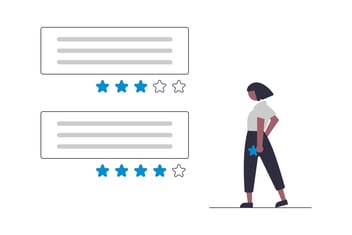How to collect customer feedback and what to do with it
Offering an excellent customer experience is the best way for businesses to stand apart from their competition, which is why it is even more of a priority than products and pricing. That’s because customers are willing to pay more for a better customer experience, and will switch to a competitor if a business isn’t up to their standard. Collecting and monitoring customer feedback is such a crucial process for improving your practices and keeping customers satisfied.
But what is the best kind of customer feedback? And what should you do with it? We’re here to give you the answers.
What is customer feedback?
Customer feedback is any information given by a customer about their experience with a product, service or brand. The insights that businesses can gain from this feedback are the key to improving products, customer service, customer support, and marketing.
Feedback can be collected through surveys, interviews, reviews and analytics, all of which offer different strategic benefits. It can be explicit or implicit and can, obviously, be positive or negative. That’s why we’ve put together this blog to guide you through the process of asking for feedback, and which strategy may suit your business best.
A customer's feedback is vital because it helps you stay in touch with their values, priorities and expectations. If you listen to their input and implement appropriate changes, your business will grow like never before.
The best ways to collect customer feedback
Not all feedback is the same, and the method you choose can influence the success of your results. So how can you find the right feedback channel for your customers? To help you make sense of it all, we’ve put together a summary of the most valuable channels, and how and when to use them.
Form-based surveys
One of the most common and more traditional channels used for online feedback, form-based surveys are a popular option. However, while these forms are useful, there are a few key things to remember when implementing them.
For starters, it’s important to keep these forms short and specific. Remember, your customers are filling this survey out as a favour, so it needs to be easy, convenient, and relevant. Studies show the length and quality of survey responses decline steeply the more questions the survey asks, so less is more. We recommend aiming for 5-10 questions, and to ensure they’re concise and open-ended. This way customers can give detailed answers and surprise you with information you might have otherwise missed.
You should only send long form-based surveys to engaged customers because they are most likely to take the time to provide valuable answers. It isn’t a good idea to send these surveys to dissatisfied customers because your main priority is to resolve their frustrations, and not give them a job to do. With this in mind, some good examples of when to use these surveys would be when a customer makes a repeat purchase, regularly participates in a loyalty program or is actively participating in an online course.
It’s also important to get feedback from unhappy customers, and to learn where improvements need to be made. Having a survey for people that leave, cancel subscriptions, or haven’t bought in a while can be a business’s best weapon for retaining future customers.
Webpage widgets and in-app surveys
Website and in-app surveys are increasingly popular for gathering feedback because they are short, immediate and seamless. Since the customer is currently using the website or app, any feedback you gain from them tends to be specific and direct which makes it more useful and easier to apply to meaningful change.
These surveys are far shorter than form-based surveys and typically ask about specific features of a webpage or app such as design, functionality or any errors. This way you can find problems faster, refine your app efficiently and customise it to suit your customer’s particular preferences. To make your customer's job as quick and easy as possible, you should keep it brief and steer clear of unnecessary jargon.
Customer satisfaction surveys (CSAT)
A CSAT survey is a short, direct and targeted way to gather feedback and can be used periodically to evaluate any part of the customer journey. A customer satisfaction survey (CSAT) measures how happy your customers are to highlight where and when your customer experience is working and where it needs improvement. By focusing on customer satisfaction, you can find where the sticking points are for your customers so that they’re resolved sooner. It means you can optimise your processes to suit them and see your revenue grow as a result.
To get the most out of your CSAT surveys, make sure the questions are simple and focused, but also that the survey is user-friendly and delivered at a convenient time. The best times to use a CSAT survey are after each step in a customer’s journey, such as onboarding, post-purchase or after a customer service interaction.
Transactional emails
Transactional emails are the emails sent to confirm something, like a purchase, subscription or upgrade. While some companies use these exclusively as notifications, they are a crucial opportunity to gather valuable feedback. Since these emails follow a transaction, customers are far more likely to open these than any other type of email which means by including a survey, you’re far more likely to get responses. These customers have just positively engaged with your company so they’re far more likely to be willing to complete a survey and give valuable feedback. Whether you link to a CSAT survey or a long-form survey, this is a great place to foster a dialogue with customers and find out more about their experiences.
Implicit feedback
Surveys are the best way to gather explicit feedback, but they aren’t the only way to get information from your customers. In fact, implicit feedback is just as valuable and can be found through data patterns across your business. Implicit feedback is harder to identify and not communicated directly to a business but is found by tracking the actions of your customers. Customers switching from your brand to a competitor, dropping out of purchases or unsubscribing from your email list are all good examples of implicit feedback, and each highlight something going wrong in your customer’s journey.
Customer feedback analytics
Customer feedback analytics is the process of recording data, extracting insights and highlighting the problem areas. By using customer feedback analytics you can monitor these patterns, pinpoint any problems and take steps to fix them.
There are many feedback management platforms designed to make this process easier so just check out this list to find a good fit for you.
Website analytics and user behaviour
One useful application for analytics is to track user patterns on your website. By measuring click-through rates, page views, bounce rates and session length, you can find where and when customers are engaging, and when they decide to leave. From here, you can refine your website to suit their preferences and see their satisfaction levels rise.
Identify key promoters
By finding your happiest customers with surveys and analytics, you can nurture and encourage them to be enthusiastic promoters of your brand. These customers have the power to influence others to engage with your brand by giving reviews and sharing referrals so it is well worth taking the time to find them and foster a strong relationship with them.
Identify unsatisfied customers
On the other hand, finding which customers are unhappy is equally important. You can use analytics to group customers into useful categories such as new visitors, free trial converts, repeat customers or first-time buyers which makes it considerably easier to find out how each group’s experience has been. If you notice one group is significantly less satisfied than another, you can use this information to zero in on their concerns, and resolve them before they abandon your brand.
What to do with the data you have collected?
Throughout this article, we’ve given examples of how to use the feedback you receive because we know feedback is worthless without pairing it with action. Every piece of feedback should be used in one way or another, so find the most effective action point for yours in the list below.
- Improve products and services.
- Optimise your website and apps to make them user-friendly and appealing.
- Identify happy customers and nurture them to be brand advocates.
- Find unhappy customers and resolve their frustrations.
- Boost your marketing and sales efforts.
- Hone in on problems and glitches.
- Perfect your customer service processes.
Well there you have it, everything you need to know about customer feedback and why it matters. Now you can implement a strategy to make the most of your customer feedback and use it to optimise your business performance.
For more information, download our guide to implementing a customer feedback strategy. You can find tips and tools to harness the power of customer feedback and all the business growth that comes with it.



